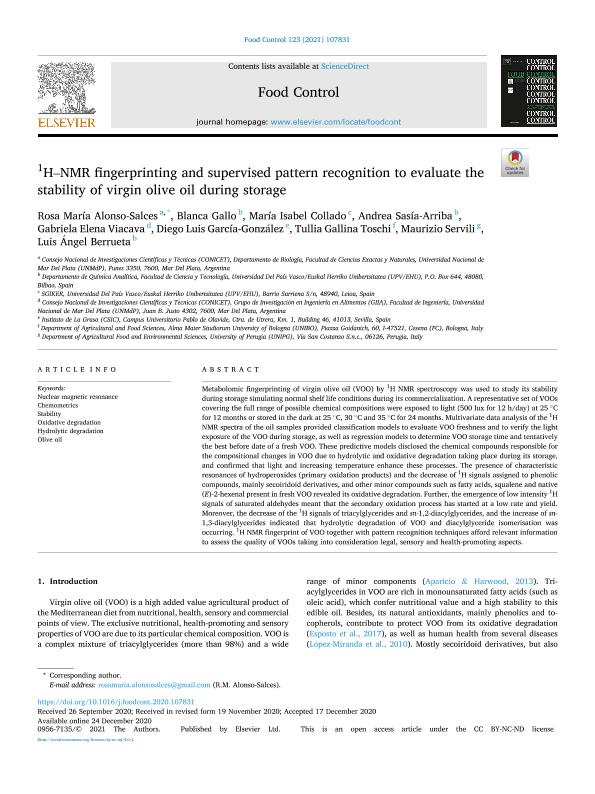Mostrar el registro sencillo del ítem
dc.contributor.author
Alonso Salces, Rosa Maria

dc.contributor.author
Gallo, Blanca
dc.contributor.author
Collado, María Isabel
dc.contributor.author
Sasía Arriba, Andrea
dc.contributor.author
Viacava, Gabriela Elena

dc.contributor.author
García González, Diego Luis
dc.contributor.author
Gallina Toschi, Tullia

dc.contributor.author
Servili, Maurizio
dc.contributor.author
Berrueta, Luis Ángel
dc.date.available
2022-03-17T13:56:12Z
dc.date.issued
2021-05
dc.identifier.citation
Alonso Salces, Rosa Maria; Gallo, Blanca; Collado, María Isabel; Sasía Arriba, Andrea; Viacava, Gabriela Elena; et al.; 1H–NMR fingerprinting and supervised pattern recognition to evaluate the stability of virgin olive oil during storage; Elsevier; Food Control; 123; 5-2021; 1-13
dc.identifier.issn
0956-7135
dc.identifier.uri
http://hdl.handle.net/11336/153515
dc.description.abstract
Metabolomic fingerprinting of virgin olive oil (VOO) by 1H NMR spectroscopy was used to study its stability during storage simulating normal shelf life conditions during its commercialization. A representative set of VOOs covering the full range of possible chemical compositions were exposed to light (500 lux for 12 h/day) at 25 °C for 12 months or stored in the dark at 25 °C, 30 °C and 35 °C for 24 months. Multivariate data analysis of the 1H NMR spectra of the oil samples provided classification models to evaluate VOO freshness and to verify the light exposure of the VOO during storage, as well as regression models to determine VOO storage time and tentatively the best before date of a fresh VOO. These predictive models disclosed the chemical compounds responsible for the compositional changes in VOO due to hydrolytic and oxidative degradation taking place during its storage, and confirmed that light and increasing temperature enhance these processes. The presence of characteristic resonances of hydroperoxides (primary oxidation products) and the decrease of 1H signals assigned to phenolic compounds, mainly secoiridoid derivatives, and other minor compounds such as fatty acids, squalene and native (E)-2-hexenal present in fresh VOO revealed its oxidative degradation. Further, the emergence of low intensity 1H signals of saturated aldehydes meant that the secondary oxidation process has started at a low rate and yield. Moreover, the decrease of the 1H signals of triacylglycerides and sn-1,2-diacylglycerides, and the increase of sn-1,3-diacylglycerides indicated that hydrolytic degradation of VOO and diacylglyceride isomerisation was occurring. 1H NMR fingerprint of VOO together with pattern recognition techniques afford relevant information to assess the quality of VOOs taking into consideration legal, sensory and health-promoting aspects.
dc.format
application/pdf
dc.language.iso
eng
dc.publisher
Elsevier

dc.rights
info:eu-repo/semantics/openAccess
dc.rights.uri
https://creativecommons.org/licenses/by-nc-nd/2.5/ar/
dc.subject
CHEMOMETRICS
dc.subject
HYDROLYTIC DEGRADATION
dc.subject
NUCLEAR MAGNETIC RESONANCE
dc.subject
OLIVE OIL
dc.subject
OXIDATIVE DEGRADATION
dc.subject
STABILITY
dc.subject.classification
Química Analítica

dc.subject.classification
Ciencias Químicas

dc.subject.classification
CIENCIAS NATURALES Y EXACTAS

dc.title
1H–NMR fingerprinting and supervised pattern recognition to evaluate the stability of virgin olive oil during storage
dc.type
info:eu-repo/semantics/article
dc.type
info:ar-repo/semantics/artículo
dc.type
info:eu-repo/semantics/publishedVersion
dc.date.updated
2022-02-15T21:00:16Z
dc.journal.volume
123
dc.journal.pagination
1-13
dc.journal.pais
Países Bajos

dc.journal.ciudad
Amsterdam
dc.description.fil
Fil: Alonso Salces, Rosa Maria. Universidad Nacional de Mar del Plata. Facultad de Ciencias Exactas y Naturales. Departamento de Biología; Argentina. Consejo Nacional de Investigaciones Científicas y Técnicas. Centro Científico Tecnológico Conicet - Mar del Plata; Argentina
dc.description.fil
Fil: Gallo, Blanca. Universidad del País Vasco; España
dc.description.fil
Fil: Collado, María Isabel. Universidad del País Vasco; España
dc.description.fil
Fil: Sasía Arriba, Andrea. Universidad del País Vasco; España
dc.description.fil
Fil: Viacava, Gabriela Elena. Universidad Nacional de Mar del Plata. Facultad de Ingeniería. Departamento de Ingeniería Química. Grupo de Investigación en Ingeniería en Alimentos; Argentina. Consejo Nacional de Investigaciones Científicas y Técnicas. Centro Científico Tecnológico Conicet - Mar del Plata; Argentina
dc.description.fil
Fil: García González, Diego Luis. Universidad Pablo de Olavide; España
dc.description.fil
Fil: Gallina Toschi, Tullia. Universidad de Bologna; Italia
dc.description.fil
Fil: Servili, Maurizio. Università di Perugia; Italia
dc.description.fil
Fil: Berrueta, Luis Ángel. Universidad del País Vasco; España
dc.journal.title
Food Control

dc.relation.alternativeid
info:eu-repo/semantics/altIdentifier/url/https://www.sciencedirect.com/science/article/pii/S0956713520307477
dc.relation.alternativeid
info:eu-repo/semantics/altIdentifier/doi/http://dx.doi.org/10.1016/j.foodcont.2020.107831
Archivos asociados
